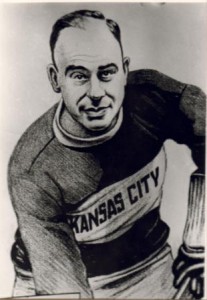 Bert McLeod can qualify for Collingwood’s Sports Hall of Fame in several categories because he excelled in every game he ever tried.
Bert McLeod can qualify for Collingwood’s Sports Hall of Fame in several categories because he excelled in every game he ever tried.
As a student in the Collingwood Collegiate over seventy years ago, he won the junior, intermediate and senior athletic awards in senior athletic awards in successive years and played fullback on the C.C.I. first ruby-football team.
As a member of the Collingwood Y.M.C.A. he stared in basketball, volleyball, track and field, gymnastics, baseball and lacrosse.
Bert played on Collingwood Junior O.H.A. teams for several years and then became a key defenseman with the Collingwood Intermediate team that lost only four games in three years- winning the provincial title in 1918-19-20.
Bret moved on to Peterborough in 1921 where he led the Lift Lock City team to two O.H.A. Senior “A” championships.
He turned professional with Kansas City in the mid twenties and pioneered the game in the mid-west American city as a player and coach.
During his seven-year win three championships and was never out of the play-offs. After his long athletic career he operated a successful pharmacy in Peterborough.
Category Archives: Inductee – Gender
JACK STOUTENBURG
Jack Stoutenburg makes the Sports Hall of Fame on a bicycle. He was the top bike
racer of his days in the Georgian Bay district and probably one of the best in Canada when bicycle racing was a major sport.
Would you believe that a crowd of 3,000 came to Collingwood to watch a five mile bike race just after the turn of the century? He became prominent as a bike race almost overnight when he won surprise victory over the famed McKee brothers, Art and Jack, of Barrie in a five-mile race at Meaford.
He accumulated a case full of trophies and medals from 1904 to 1912.
Although the five-mile events was his most specialty, Jack won one & two mile events but his most important one-miler was a victory at the C.N.E. track in Toronto in 1908. He almost missed that race when he took the wrong street car from the Union Station and ended up in Scarborough. Still lugging his racing bike he finally made it with the co-operation of two or three kindly street car conductors. He was on his mark a few seconds before starting time and did not have time to procure a starter- that’s the fellow who gives the rider a shove when the starting gun is fired and Jack had to mount from a dead start. This cost him several precious seconds and by that time the field had a fifty-yard lead. But he caught them on the third lap and he won the race
by the width of a bicycle tire They say it was the greatest mile bike race ever witnessed at the C.N.E. grounds but another sporting event got he headlines that day. It seems that on that same afternoon, Tommy Longboat, the peerless Canadian Indian runner, won a fifteen- mile foot race against the great Alfie Shrubb of England.
Jack Stoutenburg continued racing bikes until 1912. Not because he was physically
finished. He just ran out of competition. Jack passed away in his 90th year.
WALTER ROBINSON
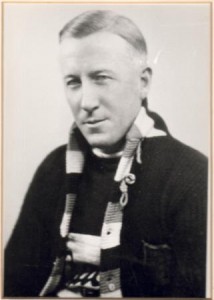 Born in Streetsville, Walt Robinson came to Collingwood with his parents as a very
Born in Streetsville, Walt Robinson came to Collingwood with his parents as a very
young boy.
He played hockey, lacrosse and baseball for Collingwood junior teams in the early
parts of this century but his mark was made as a coach and trainer.
Walt played and coached to win and he never tired to cover his contempt for laughing
losers. He regarded a loss as a team to show it on their faces.
He started coaching Collingwood hockey and lacrosse teams in 1910 but his greatest
success came in 1918-19-20 when he guided the Collingwood Shipbuilders to three
consecutive O.H.A. Intermediate “A” championships. Newly Lalonde
brought him up to the international Hockey League as a trainer with the Niagara
Falls Cataracts in 1930. He ended up coaching that team when Newsy quit in mid
season.
The Falls club disbanded and Walt went back to the O.H.A. where he brought the
Parry Sound Shamrocks to the Junior semi-finals.
For the next three years he was head hockey coach for the R.C.A.F. at Camp Borden
and twice brought the Flyers top the semi-finals.
He finished his coaching career with Collingwood in the early thirties.
On Walt’s recommendation, Leo Dandurand signed Jack Portland after only one year’s experience in Intermediate ranks. Portland starred for ten years in the National Hockey League and was a member of the Stanley Cup winning Boston Bruins in 1939.
Walter Robinson died on June 23rd, 1968. He was seventy-eight.
AL GREIR
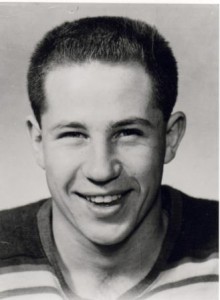 Since playing Old Timers he has competed in over 2000 games, many
Since playing Old Timers he has competed in over 2000 games, many
tournaments, won many medals, too numerous to mention. Alan coached Minor hockey for twenty years.
Football 1952,53,54,55 – Played football for CDCI
Track & Field 1952,53,54,55 – Competed in 100, 200, half mile, pole
vault and 2 Senior Championships, also numerous track events including the
Tud-Hope meets & represented central Vancouver Island at the Senior B.C.
Summer Games.
1950-59 – Numerous Hardball and Fastball Teams in Collingwood, winning
Fastball Championship in 1959.
Golf 1953 – CDCI Golf Championship
1958 – Collingwood Golf & Country Club Handicap Championship
This evening June 9, 2000 marks the induction of Alan Greir into the Collingwood Sports Hall of Fame in the Players’ category.
ARTIE CLARK
His playing weight hovered around 150 pounds but he hit like a heavyweight and
stickhandled in the fashion of the legendary Rabbi Fryer. Artie Clark was a
forward but his body checking ability had just as much effect on opposing
players as a hitting defenseman. Defensemen stopped them at the blue line-Artie
dropped them at centre ice.
His athletic capabilities were not confined to hockey. He was equally adept in the games of baseball, softball and lacrosse and he even played creditable game of cricket. He pitched, caught and played the infield in baseball. We can recall many ball games back in the twenties when Artie caught the first four innings and then finished the game on the mound. He just turned fifteen when he made the Collingwood junior team in 1920. In 1921, he was a member of the exceptionally good Collingwood junior club that almost beat Howie Morenz and the Stratford Midgets in a sudden death semi-final game in the old Toronto Mutual Street Arena. Stratford went on to win the Dominion title.
He was stil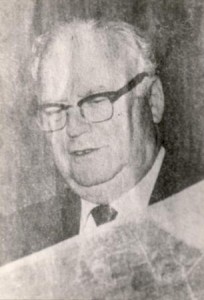 l with Collingwood when they lost out in the O.H.A. semi-finals to Aura Lee and University of Toronto in 1922 and 1923. He moved up into the intermediate ranks with Collingwood the following year and then helped
l with Collingwood when they lost out in the O.H.A. semi-finals to Aura Lee and University of Toronto in 1922 and 1923. He moved up into the intermediate ranks with Collingwood the following year and then helped
the Grimsby Peach Kings win the Ontario title in 1925. That was the year the Peach Kings stunned the amateur hockey circles by beating the Soo Greyhounds in the first round of Allan Cup play. He stayed with the Peach Kings another year
and turned professional with the old Chicago Cardinals in 1927. In 1928, he was up with the leading scorers with the Kitchener Millionaires in the International League and had another good year with Teddy Oakes’ Toronto Millionaires in 1929.
The following year he signed with the Cleveland Barons where he teamed up with three other Collingwood born players, Reg Noble, Bern Brophy and Mike Brophy. Artie had a season with Syracuse and finished an eighteen-year in Oklahoma City in 1935.
ALLAN MORRILL
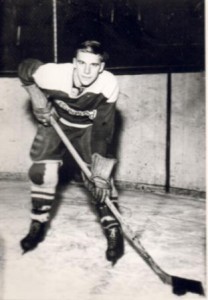 To say that Allan Morrill is a member of one of Collingwood’s great hockey families would be the understatement of the century. Allan will join his great uncle, Ernie “Rabbi” Fryer; his father Bobby Morrill, of the greatest amateur centre and goal scorers of all time; his two cousins, Barney Walmsley and the late Ab Kirby.
To say that Allan Morrill is a member of one of Collingwood’s great hockey families would be the understatement of the century. Allan will join his great uncle, Ernie “Rabbi” Fryer; his father Bobby Morrill, of the greatest amateur centre and goal scorers of all time; his two cousins, Barney Walmsley and the late Ab Kirby.
Allan’s active hockey career was far too short. Had he chosen to continue after his junior days, he would undoubtedly have made the NHL.
He had everything –superb stick-handling ability, speed, courage and a shot that could tear out the end of a net.
His ability to score goals can be attested in his splendid goal production when the Collingwood Greenshirts won their first Ontario Junior title in 1950.
In a 15 game regular schedule he scored 25 goals and assisted on 18 more. In the 17 game playoff series, he “lit the lamp” 21 times and was accredited with 20 assists. That makes a total of 46 goals, 38 assists for a total of 84 points.
That year, Morrill and his team mates of Frankie Dance and Jimmy Barrett rolled up the astounding mark of 184 points. Needless to say, Dance and Barrett are also in Collingwood’s Sports Hall of Fame.
Allan’s first provincial medal came in 1949 with Porky Young’s juvenile champions. He was teamed with Frankie Dance and Jim Barrett that season and for the next four years the line held together to win four straight Junior “C” championships. Morrill and Barrett also added a pair of OHA Intermediate “A”’ medals when Eddie Bush called them up to the Shipbuilders Intermediate finals in 1952 and 1953.
The Barrett-Morrill-Dance line was probably the greatest scoring combination in Collingwood’s hockey history. Its passing plays could be described as “Poetry in Motion”. With that combination there was no such a thing as “giving the puck away”. Every move was made as if it was planned on the drawing board beforehand. Dance
would lay out the pass to the point from left or right with deadly accuracy. He did not even have to lift his head because he knew that either Morrill or Barrett would be on the receiving end and the shot on goal was automatic. That kid line accounted for 444 goals and 347 assists for a point total of 791 scoring points during the four year span they were together.
His greatest scoring feat came in the final game of the 1952 Collingwood-Ingersoll series. Morrill scored five goals and assisted on a sixth as the Greenshirts won 7-5. He drew a standing ovation from a crowd of 2,000 as he skated to the dressing room three minutes before the end of the game.
Allan left Collingwood for Gananoque in 1953. He played part of a season for Kingston Seniors before calling it a career in 1954.
Allan Morrill was inducted into the Collingwood Sports Hall of Fame on June 11, 1986.
TOM FOLEY
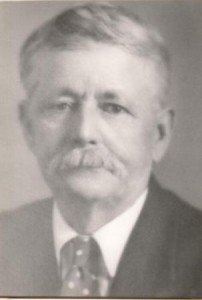 Very few old timers are alive to-day to recall the rowing exploits of Thomas “Iron Man” Foley.
Very few old timers are alive to-day to recall the rowing exploits of Thomas “Iron Man” Foley.
The glamorous days of the great waterfront regattas are long past but seventy-five years ago rowing was the number 1 sport in this neck of the woods.
Foley built his own sculling shell and he learned the rudiments of the game without benefit of a professional coach. But he met and defeated some of the greatest scullers of his days-Jack Gaudaur, father of the president of the Canadian Football League, Matt Bisley, Mel Herman, Ben Dempster, Billy Gerioux, Frank Gaudaur, Billy Hamilton and Bob Kennedy- the rowing giants of the eighties and the nineties.
Jack Gaudaur, winner of the famed Diamond Sculls and a consistent winner in the Henley-On-The-Thomas classic, met Foley twice. Foley beat him in Midland and Jack reversed the decision in Orillia on Dominion Day, 1896.
Bob Kennedy was the American champion seven years in a row and Tom Foley beat him twice in one afternoon.
At the height of his career he hung up his oars. He was in the process of raising a large family and building a successful leather tanning business and he could not afford the time to train. It was Ned Hanlon,Canada’s greatest oarsman, who said. “Foley could have won a world title had he stayed another three years”.
Tom Foley died May 4th, 1939. We have always regretted that many of his trophies were destroyed in the fire which swept through the Huron Institute about 25 years ago.
PETE STOUTENBURG
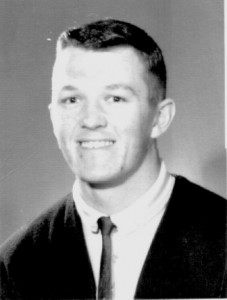 Ask anyone who saw him skate what kind of hockey talent Peter Stoutenburg had and their answer instead invariably ends with, “he was pretty good, but he was an even better person.”
Ask anyone who saw him skate what kind of hockey talent Peter Stoutenburg had and their answer instead invariably ends with, “he was pretty good, but he was an even better person.”
“The legacy he left was that he was such a decent person that you couldn’t find anyone else who had more integrity,” said Don French, who grew up playing hockey, working with and being the best friend of Stoutenburg. “If someone needed a helping hand, Pete was the first one in the dressing room to stand up and spearhead the effort.”
He played Jr. “C” as an under-aged bantam and soon movedup to the Jr. “A” ranks with Kitchener, Niagara Falls and eventually in the Montreal Metro League in 1964. After two seasons with the New England Amateur Hockey League, Stoutenburg studied and played hockey at the long-time NCAA Division One program at the University of New Hampshire. In his final year of college hockey, Stoutenburg had five goals and 20 assists in 31 games and set a record for UNH defenders with a goal and four assists in one contest.
The NHL’s Montreal Canadiens came calling and Pete attended training camp with them in 1970. He was offered a spot on the Muskegon Michigan team in the old Colonial League, but opted to pursue a career in business.
After two seasons with the New England Amateur Hockey League, Stoutenburg studied and played hockey at the long-time NCAA Division One program at the University of New Hampshire. “He always said he wasn’t exactly the best goal scorer but when you saw him skate, you felt a lot more confident about how he played,” said wife Marsha, whom Pete met while at UNH.
Stoutenburg went on to become successful in the insurance industry and was posthumously honoured by Clarica at that company’s recent convention in San Antonio, Texas for his community work.
Hockey was always a passion, however, as he played senior hockey in Barrie and Galt and coached at the Minor, Jr. ‘B’ and University levels St. Catherines, where Marsha resides.
Old-timers’ hockey was a mainstay for Pete and he always returned to the Collingwood area a couple of times a year to play in tourneys with the Legion Vets. That core of players nearly won an all-Ontario title as bantams in 1960-61. Old-timers’ hockey was a mainstay for Pete and he always returned to the Collingwood area a couple of times a year to play in tourneys with the Legion Vets. That core of players nearly won an all-Ontario title as bantams in 1960-61.
Pete took up long-distance cycling with daughter Marlo. She has become a top-flight rower, unable to attend Pete’s induction into the Hall of Fame ceremony as she was in competition at the Boston Marathon of rowing competitions on the Charles River. “If Peter was around he’d say Marlo should go to Boston instead of going to something for him,” Marsha said.
Son Curtis played Jr. ‘B’ in Thorold and at Brock University and had his first child Aug. 27 with wife Vicky. Unfortunately, Stoutenburg is the lone deceased member of the class of 2004 to enter the Collingwood Sports Hall of Fame.
Pete died of a heart attack in 2002 on a trip to his hometown of Collingwood, where he’d just purchased a condo.
WILLIAM “SCOTTY” CARMICHAEL
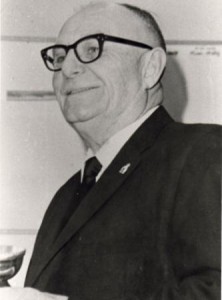 Scotty Carmichael became the 25th member of the Sports Hall of Fame. He was nominated and inducted by his fellow members of the selection committee, without his knowledge, at the first induction ceremonies.
Scotty Carmichael became the 25th member of the Sports Hall of Fame. He was nominated and inducted by his fellow members of the selection committee, without his knowledge, at the first induction ceremonies.
He is credited with the establishment of the Collingwood Sports Hall of Fame.
A sports reporter for various daily newspapers, radio and television stations, he
has been connected with many sports organizations for fifty-five years.
During this time he served as president of the Collingwood Senior Hockey League, the
Collingwood District Fastball League, Collingwood Junior Football League and
served as secretary and on and on the executive of Collingwood Intermediate and
Junior O.H.A. teams and the Collingwood Minor Hockey Association. He also
coached junior baseball teams and was actively engaged in long distance running
back in the mid-twenties.
JIM SINCLAIR
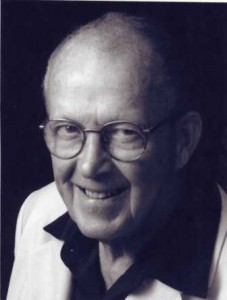 Having never been much of a cross-country skier as a youth, Duntroon’s Jim Sinclair still can’t explain why he became so involved with the sport that has earned his induction as a builder into the Collingwood Sports Hall of Fame.
Having never been much of a cross-country skier as a youth, Duntroon’s Jim Sinclair still can’t explain why he became so involved with the sport that has earned his induction as a builder into the Collingwood Sports Hall of Fame.
After being exposed to Nordic skiing while on a three-year teaching stint in Sault Ste. Marie in the early ’60s, the 74-year-old Sinclair stepped into the coaching role of the Collingwood Collegiate’s cross-country squad for almost 20 years while also serving as an automotive instructor at the school. “I don’t know why we were drawn to
it, but we were. We used to ski as a family at Blue Mountain all the time – and I know it seems like a pittance now – but $5 for a lift ticket was too much,” Sinclair said. “So we tried something different. I took some technique lessons and it just grew from there. It was a pretty young sport at that time. Another teacher, Greg Titus, tried to get a Nordic team going, but he was involved with so many other sports, so I put my name in.”
Sinclair literally wrote the book on organizing cross-country skiing races for the
Southern Ontario Division for the provincial sports association and he helped
establish the successful Highlands Nordic facility in Duntroon, which is now owned and operated by his oldest son, Larry. With approximately 500 members and over 21 kilometres of trails, Highlands Nordic has become a world-class facility that has hosted several major competitions, including national championships, the 1993 world high school meet and the 1997 Special Olympics World Winter Games.
Sinclair played a key organizing role in those events, along with many others, including the 1991 Ontario Winter Games and the OFSAA championships in 1974 at Kolapore.
He downplays his role as a catalyst behind the development of Highlands Nordic and cross-country skiing at CCI and in southern Ontario in general, but his dedication continues to this day. He planned and worked on trails in Loree Forest, what is now Central Park in Collingwood and Huron Highlands and began hosting Georgian Bay and Ontario high school meets.
“I always said I was never going to do another trail after those and then I got into it big time at Highlands Nordic,” the Ottawa native added. “(Duntroon Highlands Golf Club founder) Dalt Sampson started the skiing and he cleared a lot of the trails himself. I don’t think that man ever skied, but he knew enough to make a nice, wide trail and didn’t make turns at the bottom of hills. Everything was done right the first
time around.”
This evening, October 23, 2004, the Collingwood Sports Hall of Fame welcomes Jim
Sinclair as an enshrined member for his role as a Builder of our athletic community.
